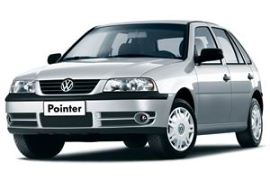VOLKSWAGEN Pointer Models/Series Timeline, Specifications & Photos
First production year: 1994
Engines: Gasoline
Body style: Hatchback
Usually, the badge-engineering process is seen inside a big carmaker. Ford, General Motors, Volkswagen, and Chrysler are already known for that. But in 1994, Volkswagen and Ford signed an agreement that led to the introduction of the VW Pointer for the South American market.
In 1992, Ford and Volkswagen joined forces and produced cars for Brazil and Argentina. Basically, those were Ford vehicles with Volkswagen engines. But the agreement went even further with the introduction of the Pointer in 1994. This time, the badge on the car reflected the engine manufacturer, not the bodywork maker.
Seeing a car that resembled a Ford Escort being fitted with a VW badge and front fascia would have been a shock for the European and British customers. In Mexico, on the other hand, there was no problem with that. Thus, the compact, blue-oval developed Escort gained a Passat-inspired grille and headlights. However, the rest of the bodywork still featured the three-window profile and the sloped rear end specific to the Escort.
Inside, the dashboard featured a tall and wide cluster covering the instrument panel and the center stack. Volkswagen's design department made the vents' look and dials, but they didn't follow the same language as the exterior. Yet, it was functional, and the customers were OK with that. At the same time, the front bucket seats and the rear bench were made by Ford to ease the assembly process.
Under the hood, the Pointer came with a 1.8-liter, naturally aspirated gasoline engine. It was paired as standard with a five-speed manual. Both were produced by Volkswagen especially to meet the South-American standards.
